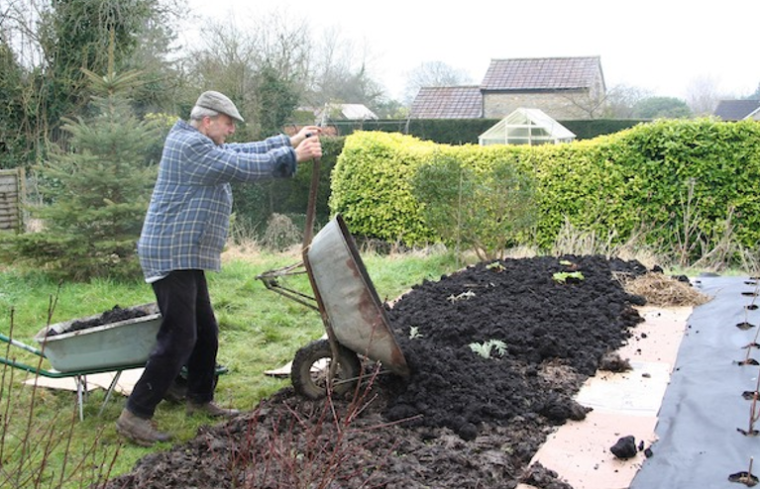
lyering rotted manure on cardboard
March, especially in a lockdown, is a good time to begin new kitchen garden. Having moved to ‘pastures new’, as rector of Bunclody Union, it’s time to get to know new people – and new soil.
When I first had a chance to design a garden, I was in my twenties. Now, having turned sixty, the prospect of double digging a number of raised beds is not a task my redoubtable back looks forward to. A very kind local parishioner has offered to plough up a patch with his trusty Massey-Ferguson. However, there are good reasons to employ the no-dig method to establish vegetable beds in St Mary’s Rectory garden, Bunclody, but on a slightly larger scale than the productive no-dig garden begun, during my curacy, in the loamy soil of Tramore Rectory in Waterford Union of Parishes.
‘When you send forth your spirit, they are created, and you renew the face of the earth. May the glory of the Lord endure for ever; may the Lord rejoice in his works.’ Psalm 104 v.32.
Let’s have a conversation about starting a no-dig garden:
How do I begin a no-dig garden?
If you have a veg patch already, then what is recommended is to remove any visible weeds and veg plants that are finished, spread well-rotted compost and stop digging. Well-rotted cow or horse manure, or spent mushroom compost, have also worked well for us in the past.
If you are starting with a very weedy plot or area which has not been used for growing before (a lawn, weedy pasture etc.), first of all cut, mow or strim the weeds to ground level, rake up and compost. It is best not to leave the cut weeds in situ as they can provide a cosy habitat for slugs and other pests. Remove woody weeds, brambles, docks, etc., by hand with a spade or trowel.
Then cover with a good layer of cardboard and then at least 4 inches/ 10 cm of well-rotted compost. Worms love cardboard and happily incorporate it into the soil.
A way to speed up the process is mulching with polythene or membrane. Always put this on the top, not underneath the compost! If you want, you can make holes in this in March to grow potatoes, or in May or June and grow squash, courgettes or similar large plants, making that area productive whilst the plastic kills off the weeds. (Try to source previously used plastic, to save resources).
What about perennial weeds, scutch, bindweed, creeping buttercup?
Once weeds are deprived of light, and the conditions in which they thrive change, they die over time. During the first year it is important to regularly check for any stray weeds that pop up through the mulch and remove these with a hand fork or trowel.
Do I need to dig first to loosen the soil?
No, it is better to preserve the existing structure and soil life. The surface mulch of organic matter (compost or manure) soon encourages soil organisms (worms and other soil flora and fauna) whose activity creates a good structure for growth.
How do I make low-cost paths?
A mulch of two layers of good strong cardboard, weighed down with stones or timber, kills off any weeds underneath usually over 9-12 months. You may need to replace the cardboard once or twice, just add more to the surface. The following year, spread some compost or wood shavings onto the paths, to create a surface that is weed free and easy to hoe.
How do I keep the plot weed free?
No dig = fewer weeds! Turning the soil over exposes annual weed seeds which encourages germination. Think of the flush of weed seedlings that usually appear a few weeks after a plot is dug over. In no dig, we are not doing this and so those weeds remain dormant. However, to help keep your plot weed free, hoe it all regularly (weekly is good) and fork out any perennial or larger weeds that escape hoeing.
How do I maintain fertility?
An annual mulch of an inch or two (2.5 – 5 cm) of well-rotted compost provides food for the soil and plants for a whole year, even hungry feeders. Outside beds are mulched during the winter, and if you have a polytunnel, or greenhouse, then in the spring just before tomatoes etc. go in.
How do I grow potatoes in a no-dig garden?
Use a trowel to make a hole in the ground, place the potato in and earth up with the surrounding compost on the bed as necessary. Harvest using a trowel. I often find that the compost is loose enough to allow me rummage for the potatoes with gloved hands.
